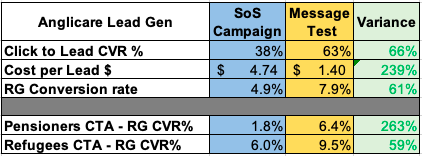Creative Message Testing
What does your target audience respond best to?
Before your next appeal or campaign, you should try some message testing to get the call to action just right for your donors and supporters.
Message testing can be done very quickly and easily within Search Ads or Facebook ads.
In this case, we used Facebook ads.
For Anglicare we did a messaging test to learn 3 things:
- Can we improve the quality of the leads we were capturing for Regular Giving conversion by telephone
- Should we change the call to action we were using?
- Did Facebook (Form) Lead Ads deliver the same kind of quality as leads from a dedicated landing page?
And we got the answer to all three questions within a 2 week period.
Why a creative message test?
We spent $1,000 over 7 days, to test 3 different creative messages, across 2 different Lead Gen Statement of Support.
So effectively we spent $500 for each theme – Refugees and Pensioners.
Anglicare’s lead gen campaign had been running for about 3 months and the Cost per Lead was about $1.00 under what we had forecast and planned for. So we were happy with that.
The conversion rate from lead to regular donor we planned for was 6%. We had started with 4 campaigns and had refined down to two. The Refugee campaign was over achieving its RG conversion rate – but the Pensioner leads were performing well below where it needed to be. Mostly because we were attracting a lot of pensioners themselves, and they weren’t in a position to give.
Anglicare felt strongly that supporting Pensioners is important and wanted to see if we could improve the message to appeal to donors who were in a position to help pensioners living in poverty.
So, we set up the message test. Improving the quality of the Pensioner leads was an important part of the test.
We also wanted to test some other messages for supporting Refugees.
Message Test Strategy + Creative

We took the best performing creative (for leads) from the Refugee and the Pensioner campaigns and used them as the control.

This was the CONTROL for the Refugee Leads. This had been the most popular Refugee ad for 3+ months.
We then created 2 alternative messages – to achieve our objective of better donor leads and to test new messages that aligned better to Anglicare’s work and audiences.

New Pensioner ad – CTA designer to speak to donor prospects, not pensioners themselves.

Pensioner message test – building on best performer with call to action adjusted for better quality leads.
We set up Lead Forms – the same ad type format that we’d been using before, but a different way to capture the lead data – and we ran the ads for about 7 days.
We had the ad click through rates, Cost per Lead $ and the conversion rates to RG from the campaign we’d been running for 3 months, this was what we were comparing the Test results against.
What we ended up with looked like this.
Message Test Results

The Cost Per Lead was lower than anything we could have imagined (and this is for phone leads).
We were able to generate over 700 leads in 7 days, at a $1.40 cost per lead. I was expecting maybe $3.00.
So yes, with a small change in the message to ask people “Can you help pensioners living in poverty?” – we were able to improve the quality of the Pensioner leads, as proved by the higher conversion rate to regular giver.
Yes, the Facebook Lead ads can deliver the same quality as leads to a dedicated landing page – but we don’t yet know how sticky these leads will be.
Should we change the call to action we were using? For pensioners – yes. For Refugees, no. The control ad still outperformed all others.
There was one disappointing learning from the test. We tested a positive message about refugees, rather than a message of lack – and it was by far the poorest performer. This saddened me.
So now that we’ve optimised one lead gen campaign, we’re building the next campaign by using message testing in the early planning stages to get the call to action right for prospective donors.

